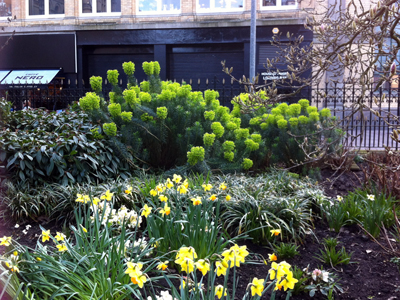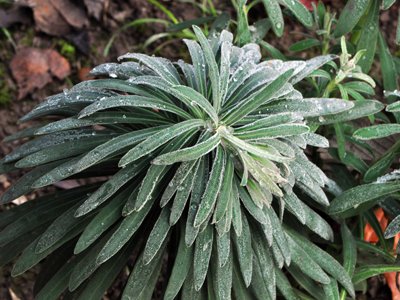It’s strange the things you remember. I recall an English lesson once when we read a poem that was about your senses sometimes being heightened when you are grieving.
In this case, the poet casts himself on the ground, distraught, and notices for the first time that “The woodspurge has a cup of three”. You can read the poem, by Dante Gabriel Rossetti, at the end of this post.
The woodspurge is Euphorbia amygdaloides, although to be honest I visualised it as the sun spurge that grew as a weed in our garden, Euphorbia helioscopia.
Many Euphorbias have a “cup of three” – hopefully illustrated by my pictures. But it is a huge and diverse genus including more than 2,000 species.
The example pictured here is a big cultivated Eurphorbia, but the spurges mentioned earlier are small British wild flowers.
To me, typical Euphorbias have a distinctive bright lime green colour. But clearly not all of them do, as I hadn’t realised that bright red Poinsettia is also a Euphorbia.
Over the last few months I have been watching the new Euphorbia characias (possibly subsp. wulfenii) in my neighbour’s garden. It’s so photogenic…
This big Euphorbia is in Cardiff’s city centre…

Acid-green Euphorbia and daffodils in the gardens between St John the Baptist Church and the Old Library, Cardiff city centre, March 6, 2012 - an iPhone snapshot...
Euphorbus was Greek physician to Juba (52/50 BC-AD 23), king of Numidia and then Mauritania. By the way, Juba’s wife was the daughter of Mark Antony and Cleopatra.
Euphorbus identified a certain plant as a powerful laxative, always a useful thing to have, so in 12 BC, Juba named the plant after him. This was perhaps in response to the Emperor Augustus dedicating a statue to Antonius Busa, his own personal physician.
Botanist and taxonomist Carl Linnaeus later assigned the name to the entire genus. I must admit I had thought the word Euphorbia related to some feature of the plant, as is the case with many botanical names beginning with eu- . This little Greek word means “good” or “well” or “pleasing”.
Here are some examples of plant names starting with eu-, the first two from my own garden.
EUCOMIS – The name Eucomis is of Greek origin, eu- meaning “pleasing” and kome “hair of the head”, referring to the tuft of leaf-like bracts that crown the inflorescence of the species in this genus.

Euonymus alatus - also known as 'winged spindle tree' because of the flat wings on its twigs and 'burning bush' because its leaves are bright red in autumn...
EUONYMUS – The name Euonymus is an ancient Greek and Latin name for the spindle tree, eu- meaning “good” and onoma “name”. The word also came to mean “lucky”.
Then there’s:
EUCALYPTUS – The genus name Eucalyptus comes from eu- meaning “well” and kalyptos meaning “covered,” referring to the operculum on the calyx that initially conceals the flower.
EUCRYPHIA – The genus name Eucryphia means “well hidden”, because the sepals are joined at the top. These shrubs grow in the southern hemisphere.
EUSTOMA – One of my favourite cut flowers is Eustoma grandiflora, perhaps more commonly called Lisianthus or prairie gentian. The name means “lovely mouth”.
There are a couple more eu- plants named after people:
EUGENIA is a genus of evergreen shrubs and trees named in honour of Prince Eugene of Savoy, the name meaning “well-born”.
EULALIA is a small genus of grasses, named after botanical artist Eulalie Delile – the name means “well spoken”. I wonder if it’s therefore “whispering grass“?
EUPATORIUM is named after Mithridates Eupator, a king of Pontus, who first used the plant as a remedy – its common name is “boneset”.
You may have noticed there are several other words in the dictionary that begin with eu-:
EUKARYOTE – meaning “characterized by well-defined cells (with nuclei and cell walls)”, from karyon, “nut” or “kernel”.
EUPHEMISM – use of a favourable word instead of an inauspicious one, from pheme, “speaking”.
EUPHORIA – meaning “bearing well”, as originally it meant the power of enduring illness easily, although now it means “feeling well”.
Finally, that Euphorbia poem I promised you at the beginning…
The Woodspurge
by Dante Gabriel Rossetti
The wind flapped loose, the wind was still,
Shaken out dead from tree and hill:
I had walked on at the wind’s will,–
I sat now, for the wind was still.
Between my knees my forehead was,–
My lips, drawn in, said not Alas!
My hair was over in the grass,
My naked ears heard the day pass.
My eyes, wide open, had the run
Of some ten weeds to fix upon;
Among those few, out of the sun,
The woodspurge flowered, three cups in one.
From perfect grief there need not be
Wisdom or even memory:
One thing then learnt remains to me,–
The woodspurge has a cup of three.
Also see:
Who would YOU name a plant after?











Enjoyable read.
I had a childish thought about the last line of verse 2 – you must admit that with forehead between your knees the first rhyme you think of for ‘alas’ and ‘pass’ may not be ‘grass’.
Moving swiftly on, I then referenced ‘poinsettia’ in Wikipedia, to find the article at http://en.wikipedia.org/wiki/Euphorbia_pulcherrima state that in Spanish it is called ‘Flor de Pascua’ meaning ‘Christmas flower’. I don’t speak much Spanish, but I was sure that ‘Pascua’ was not ‘Christmas’!
The joy of Wikipedia is that you can edit it, so I did. But the section was headed ‘Christmas traditions’ so I had to make quite a few changes. In truth it needed a bigger edit than I can do while I eat my lunch, but it’s more accurate now.
Oh you are naughty, Paul! And my only thought was that Rossetti (a Londoner) must have been putting on a northern accent to rhyme grass and pass with alas!
Interesting about Poinsettia – I hadn’t noticed that. Do the Spanish manage to keep their Poinsettias alive until Easter, then?
Thanks for commenting – best wishes 🙂
I learned something new… nice photos
Thank you for your kind words 🙂
This is a beautiful post Pat and as the previous comment stated I learn something new from you posts. Love the Poem also. Dante Gabriel Rossette,is this one in the same Renaiss’ance artist.
Rita.
As always, Wikipedia can tell you more. He was indeed an artist as well as a poet and one of the Pre-Raphaelites, Victorians who wanted to return to the kind of “classical” art of Raphael and Michelangelo. Here’s the link.
Very interesting post..You are such a good writer and I am trying to learn as much as I can about plants….
Oh dear, you make me blush! It just spills out, I’m afraid. And I’m learning as I go along, too.
I enjoyed your talking to the birds post…
Best wishes 🙂
Thanks for flagging up the ‘talking to the birds’ blog – Had a quick look and will read in more detail when I have more time, it looks interesting and a similar approach to ‘citizen science’ to our RSPB-BTO surveys like Garden Bird watch.
Happy to show you something new for a change!
Best wishes 🙂
Beautiful post…only you could put the words to these fantastic and informative photos…I sat down on our lake edge with my laptop and let your words dance through my head…it was a calming affect and I could almost smell the rich earth of which they live…again a beautiful painted picture of words…thanks for sharing.
Thank you for your kind comments, KJ – I am imagining you beside the lake in dappled sunshine, under trees…
We have only a bird bath!
Best wishes 🙂
When I saw the first close-up photo, it looked strangely familiar. It wasn’t until I saw some of the other photos that I realized this was one of our favorite plants in the flowerbeds years ago. When it died, we never got around to replacing it, and I didn’t know the name or have any information on it. I was not aware that we had a Greek physician in our back yard, or that our plant was the subject of a poem. Thanks for sharing the information and lovely photos. I think it may be time to hunt down a replacement.
Go for it! This particular species seems pretty robust, although I suppose it takes a while to get to any size.
There seem to be lots of different cultivars, too, and I’m not sure what the one I pictured was. This “Lambrook Gold” one looks rather nice…
Thanks for stopping by 🙂
Hi there, I’m writing about Euphorbia this Wednesday for my weekly ‘weed’ and I’d like to link to you (and steal the Rossetti poem) if that’s ok? This is such an interesting piece…..I noticed the Euphorbia in the rose garden in Regent’s Park at the weekend, and realised how strange the flowers are.
Of course! No problem. Euphorbia is still a favourite of mine.
I will read your piece with interest.
All the best 🙂
Thank you!
[…] finally I am indebted to the wonderful Squirrelbasket blog for finding this poem by Dante Gabriel Rossetti. Admittedly, it’s about the woodspurge […]
Thank you for the mention (blushes…)
I thoroughly enjoyed your post and learned a few things 🙂